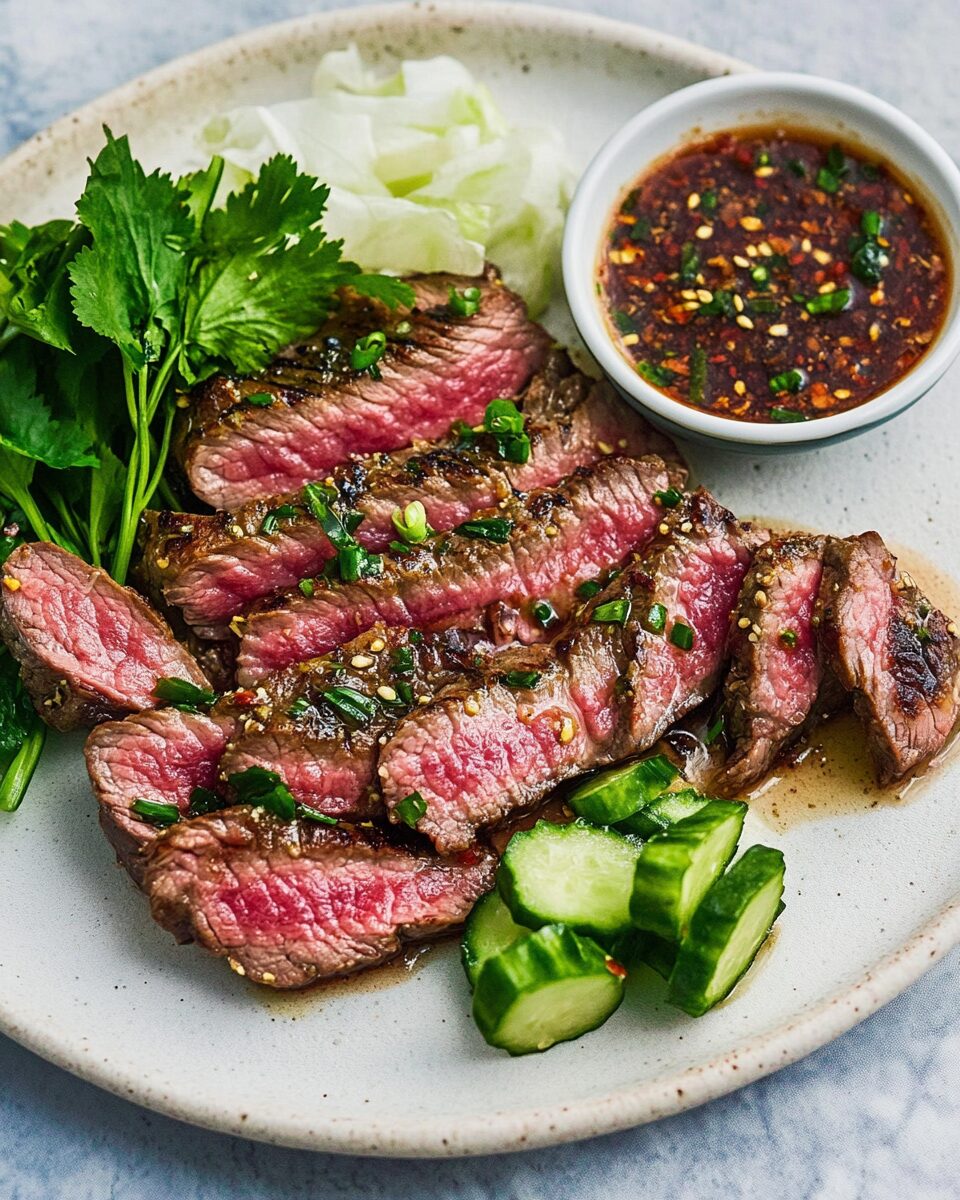The Crying Tiger Beef is a celebration of Thai street food at its boldest. Succulent slices of marinated steak are grilled to perfection and served alongside the intensely flavorful Nam Jim Jaew sauce. Every bite is a thrilling mix of savory, smoky, tangy, and spicy, showcasing the signature harmony of Thai cuisine.
This dish is more than just a grilled steak—it’s a complete sensory experience. Toasted glutinous rice adds nutty crunch, while lime, tamarind, and fish sauce layer the Nam Jim Jaew with punchy depth. Whether you’re planning a BBQ night or craving exotic comfort food, this recipe brings the heat—and heart—of Thailand to your table.
Full Recipe:
For the Beef:
-
400g sirloin steak (or any tender steak cut)
-
1 tbsp oyster sauce
-
1 tsp fish sauce
-
8g garlic, grated
-
8g ginger, grated
-
White pepper, to taste
For the Nam Jim Jaew Sauce:
-
12g glutinous rice
-
3 tbsp fish sauce
-
2 tbsp fresh lime juice
-
1 tbsp tamarind paste
-
1 tbsp evaporated cane sugar (or palm sugar)
-
2 tsp Thai chili flakes (adjust to taste)
-
10g cilantro or mint, chopped
-
10g scallion, chopped
-
16g shallot, minced
Directions:
-
Mix oyster sauce, fish sauce, garlic, and ginger in a bowl. Coat steak with marinade and let sit for at least 30 minutes (up to overnight). Bring to room temperature before grilling.
-
Toast glutinous rice in a dry skillet over medium heat, stirring constantly, until golden brown. Let cool and grind to a coarse powder using a mortar and pestle or spice grinder.
-
Combine fish sauce, lime juice, tamarind paste, sugar, chili flakes, cilantro, scallion, shallot, and 2 tsp of the rice powder in a bowl. Stir until sugar dissolves.
-
Heat grill or cast iron skillet over medium heat. Grill steak diagonally at 10 o’clock for 1½ minutes, rotate to 2 o’clock, cook 1 minute. Flip and repeat. Cook to desired doneness (approx. 5 minutes for medium rare).
-
Rest steak for 10 minutes, then slice thinly against the grain. Sprinkle with white pepper and extra toasted rice powder.
-
Serve with cucumber, cabbage, or sticky rice, and plenty of Nam Jim Jaew on the side.
Prep Time: 35 minutes | Cooking Time: 10 minutes | Total Time: 45 minutes
Kcal: 140 kcal | Servings: 2 servings
A Deep Dive into Crying Tiger Beef with Nam Jim Jaew
Crying Tiger Beef, known in Thai as Suea Rong Hai (เสือร้องไห้), is a dish as dramatic and unforgettable as its name suggests. Hailing from the Isan region of northeastern Thailand, this beloved street food captures the essence of Thai cooking: a masterful balance of flavors, textures, and traditions. Although simple in preparation, the dish embodies complexity in taste, making it an irresistible favorite among food lovers around the world.
The dish’s intriguing name—literally translated as “the crying tiger”—has several folkloric interpretations. One popular tale suggests that the beef is so delicious it could make a tiger weep. Another posits that the cut of beef used (often a rich, marbled piece like brisket or sirloin) was traditionally reserved for royalty or the wealthy, leaving the tiger to cry over its misfortune of missing out. Regardless of the story, what’s undeniable is that Crying Tiger Beef is an emotional experience on the plate—smoky, spicy, savory, and soul-stirring.
The Cultural Roots of Isan Cuisine
To understand Crying Tiger Beef is to appreciate the broader context of Isan cuisine. Isan is Thailand’s largest region, known for its rustic and bold dishes. It shares culinary DNA with Laos and Cambodia, emphasizing strong flavors, spicy dips, and fermented elements. Sticky rice is the starch of choice in Isan, and many of its most famous dishes—like larb (a minced meat salad), som tam (green papaya salad), and grilled meats with pungent dipping sauces—reflect a no-waste, flavor-driven philosophy.
Isan food is not about subtlety; it is robust and gutsy, often relying on local ingredients like fermented fish sauce (pla ra), toasted rice powder, lime juice, chili flakes, and herbs like mint and cilantro. Crying Tiger Beef fits squarely into this framework, offering a rich umami steak paired with Nam Jim Jaew, a dipping sauce that checks all the boxes of flavor: salty, sour, spicy, and sweet.
What Makes Crying Tiger Beef Stand Out
Unlike many Western steak dishes where seasoning is minimal to let the meat shine, Crying Tiger Beef elevates the meat with a marinade that infuses it with flavor and tenderness. A combination of fish sauce, oyster sauce, garlic, and ginger creates a depth that highlights the natural umami of beef while also softening its texture.
After marinating, the beef is grilled to smoky perfection, often over charcoal or a cast-iron skillet to create that iconic char. It’s then sliced thinly against the grain to ensure tenderness and sprinkled with a touch of toasted rice powder and white pepper to add layers of flavor and aroma.
But what truly elevates this dish is the Nam Jim Jaew sauce.
Nam Jim Jaew: A Masterpiece of Thai Sauces
The Nam Jim Jaew dipping sauce is a culinary work of art. It combines the heat of dried Thai chili flakes with the tang of lime juice and tamarind paste, the saltiness of fish sauce, the sweetness of palm or cane sugar, and the crunch of ground toasted rice. Fresh herbs like cilantro and mint, along with scallions and shallots, complete the profile with bright, herbal notes and a slight bite.
What makes this sauce particularly brilliant is how it complements the beef. Each dip enhances the steak’s charred exterior while cutting through the richness of the meat. Unlike creamy Western sauces, Nam Jim Jaew is light and refreshing but potent enough to dominate the palate. It’s no wonder that once you’ve tasted this combination, it becomes hard to enjoy grilled beef without it.
The Role of Toasted Rice Powder
One of the defining ingredients in Nam Jim Jaew—and in Isan cooking more broadly—is toasted glutinous rice powder. This ingredient is made by dry-roasting sticky rice grains until golden brown, then grinding them into a coarse powder. The result is a nutty, aromatic, and slightly crunchy texture that adds a rustic complexity to the sauce.
Toasted rice powder acts as both a thickener and a flavor enhancer. It absorbs some of the sauce’s moisture, giving Nam Jim Jaew a slightly gritty but pleasing mouthfeel. In Isan cuisine, this ingredient reflects a resourceful cooking style that transforms humble staples into key flavor components.
Pairings and Serving Suggestions
Crying Tiger Beef is traditionally served with sticky rice and raw or lightly steamed vegetables like cucumber, cabbage, or Thai eggplant. The rice helps temper the heat of the sauce and provides a neutral contrast to the robust beef flavors. In Thailand, this dish might be accompanied by other Isan classics such as green papaya salad (som tam) or a bowl of herbaceous larb to create a meal that’s balanced and deeply satisfying.
Although deeply traditional, Crying Tiger Beef is remarkably versatile. You can modernize the dish by using different cuts of beef such as tenderloin or flank steak, or even substitute the protein entirely—chicken thighs, pork loin, or tofu all work beautifully with the marinade and sauce. For an elegant presentation, consider slicing the steak thinly and laying it over a bed of sticky rice, garnished with herbs and a small bowl of Nam Jim Jaew on the side.
Health and Nutrition Considerations
Despite its bold taste, Crying Tiger Beef is relatively lean and healthy. The marinade uses only a small amount of oil, and the grilled preparation keeps it low in fat compared to fried dishes. The sauce, although intense, is made primarily of natural ingredients with no heavy creams or preservatives.
The use of fresh herbs like mint and cilantro adds antioxidants, while the chili flakes can help boost metabolism. Tamarind provides valuable micronutrients like magnesium and potassium, and lime juice is high in vitamin C. When paired with vegetables and moderate portions of sticky rice, this dish can be a balanced and nutritious part of your weekly meal plan.
Why Crying Tiger Beef Is a Must-Try Dish
Whether you’re a home cook seeking to expand your repertoire, a food blogger looking to showcase regional Thai dishes, or simply a lover of bold and spicy flavors, Crying Tiger Beef is a must-try. It’s one of those rare dishes that is both deeply rooted in tradition and easily adaptable to modern kitchens.
The dish offers a theatrical name, a compelling backstory, and unforgettable flavors. With minimal equipment and accessible ingredients, it’s a gateway into the world of Thai cooking that doesn’t require complex techniques or hard-to-find spices. The payoff is enormous: a steak dinner that’s smoky, spicy, tangy, and utterly addictive.
Conclusion
Crying Tiger Beef with Nam Jim Jaew is more than a meal—it’s an experience. This dish exemplifies the vibrant flavors and culinary ingenuity of Thailand’s Isan region. With just a few simple steps, you can bring the smoky aroma of street-side grills and the fiery zing of Thai dipping sauces right into your home kitchen.
While its name might suggest sorrow, the only thing you’ll be crying over is the last bite. Whether served for a weeknight dinner or a special gathering, Crying Tiger Beef is sure to impress and satisfy with every sizzling slice.






